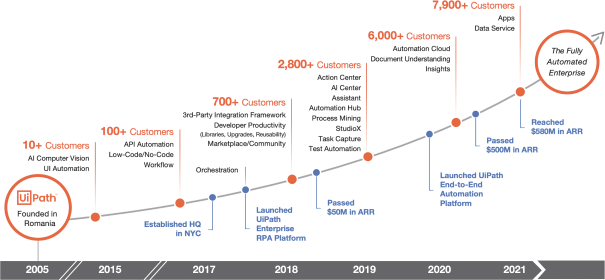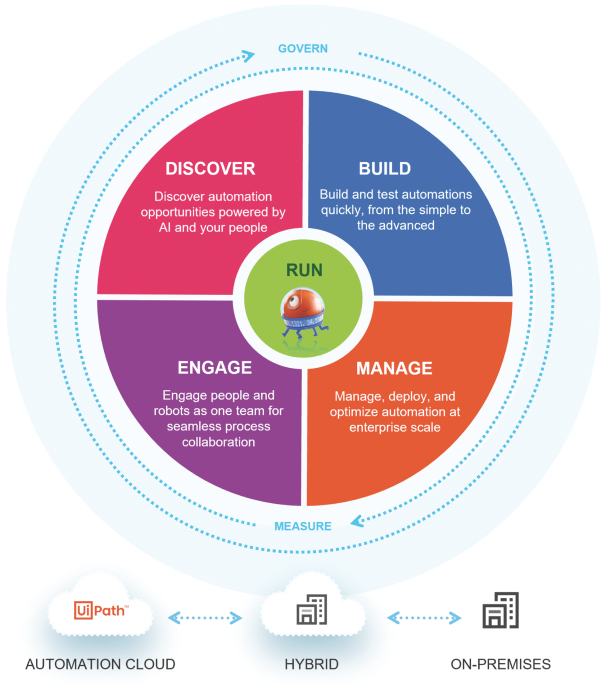Businesses worldwide spend hundreds of billions of dollars to adopt applications that help advance digital transformation and drive competitive advantages. With the proliferation of cloud technologies and software-as-a-service or SaaS, traditional software suites have been disaggregated into point solutions.
According to the Wall Street Journal, in 2019, the number of software applications deployed by large firms across all industries worldwide had increased by approximately 70% over the previous four years. These applications, which were generally not designed for interoperability, run in tandem with long-running, legacy technologies. The increasing volume of applications has a compounding effect on the complexity of business processes and the IT environments that support them.
Several technology companies have attempted to address the automation needs of organizations through the application of business process management, application development platform offerings, robotic process automation (RPA tools), AI point offerings, and other horizontal software applications.
However, these existing offerings are challenged by many inherent limitations, including the need for An End-to-End Platform, Not Capable to Emulating Human Behavior, Difficult linking AI Capabilities to Execution, and Lack of Openness and Interoperability.
UiPath aims to unlock human creativity and ingenuity by enabling a fully automated enterprise and empowering workers through automation. To understand how we decided to analyze the business model of UiPath. We will also learn how does UiPath work, what is its business model and who are its major competitors.
What does UiPath do? How does UiPath work?
The modern enterprise is complex as employees must navigate an ever-increasing number of systems and applications to perform their day-to-day work. This dynamic forces workers to constantly execute manual, time-consuming, and repetitive tasks to get their work done.
The friction faced by workers often results in lost productivity, which can have a direct impact on a company’s bottom line. Traditional automation solutions intended to reduce this friction have generally been designed to be used by developers and engineers rather than the employees directly involved in executing the automated work.
As a result, employees are limited by the need for more flexibility in these traditional automation technologies causing employee productivity, innovation, and satisfaction to suffer. UiPath is a global software company that makes robotic process automation (RPA) software. It was founded in Bucharest, Romania, by Daniel Dines and Marius Tîrcă in 2005.
UiPath’s platform is designed to transform the way humans work. UiPath provides customers robust capabilities to discover automation opportunities and build, manage, run, engage, measure, and govern automation across departments within an organization.
UiPath’s platform leverages the power of artificial intelligence, or AI, based computer vision to enable UiPath’s software robots to perform a vast array of actions as a human would when executing business processes. These actions include, but are not limited to, logging into applications, extracting information from documents, moving folders, filling in forms, and updating information fields and databases.
UiPath’s robots’ ability to learn from and replicate workers’ steps in executing business processes drives continuous improvements in operational efficiencies. It enables companies to deliver on key digital initiatives with greater speed, agility, and accuracy.
UiPath’s platform is designed to interact with and automate processes across a company’s existing enterprise stack. As a result, UiPath’s customers can leverage the power of UiPath’s platform without the need to replace or change existing business applications and with lower overall information technology, or IT, infrastructure costs.
UiPath’s platform enables employees to build automation for both existing and new processes quickly. Employees can seamlessly maintain and scale automation across multiple deployment options, constantly improve and evolve automation, and continuously track and measure the performance of automation, all without substantial technical experience.
Society is at a turning point in how organizations execute work, and the ability to leverage software to enrich the employee experience will unlock tremendous value and efficiency opportunities.
What is the business model of UiPath? Who are its major competitors?
Platform
By addressing the complete lifecycle of automation, including identifying specific tasks and processes to automate, building and managing automation software robots, deploying them to execute processes, and measuring their business impact, UiPath’s platform is intended to address a wide and diverse array of automation opportunities, including complex, long-running workflows.
Discover: Discover products combine AI with desktop recording, back-end mining of both human activity and system logs, and intuitive visualization tools, enabling users to discover, analyze, and identify unique processes to automate in a centralized portal.
Build: UiPath’s Build products are low-code development environments with easy-to-use, drag-and-drop functionality that users in an organization can learn to use to create attended and unattended automation without any prior knowledge of coding.
Manage: The products in the Manage category offer centralized tools designed to securely and resiliently manage, test, and deploy automation and ML models across the entire enterprise, with seamless access, enterprise-grade security, and endless data scalability.
Run: With Run products, an enterprise can deploy Uipath’s robots in highly immersive attended experiences or in standalone, unattended modes behind the scenes and can leverage hundreds of native connectors built for commonly used line-of-business applications.
Engage: With Engage products; users can remain connected and interact with robots, whether they are running in a data center, in the cloud, or right on their desktop.
Measure: Measure products enable users to track, measure, and forecast the performance of automation in their enterprise.
Value Proposition
Empower Customers to Deliver on Digital Initiatives: UiPath’s platform helps organizations drive otherwise time-consuming transformational initiatives quickly and easily. Organizations utilize UiPath’s platform to continuously discover and automate simple and complex tasks to increase their operations’ efficiency and resiliency.
Build Business Resiliency and Agility into Digital Business Operations: UiPath’s combination of computer vision and additional AI capabilities enables UiPath’s software robots to execute tasks just as humans would. UiPath’s robots can be deployed as attended, unattended, or in a hybrid model and seamlessly adjust as conditions change to execute manual and time-consuming tasks and processes.
Fast Time-to-Value: UiPath’s test suite enables centralized testing designed to ensure the quality of automation or applications before they go live, resulting in less time spent on maintenance and improving costs and worker productivity.
Organization-Wide Automation: UiPath’s platform enables workers throughout an organization to build automation. UiPath’s platform is designed to automate the full spectrum of business processes and tasks, from individual tasks to complex processes that address entire enterprise divisions.
Identify, Improve, and Analyze Workflow Execution: UiPath’s platform provides visibility into how work gets done and enables UiPath’s customers to continually understand, identify, and implement automation opportunities.
How does GitLab work & make money: Business Model
Improve Employee Productivity, Experience, and Satisfaction: UiPath’s platform enables organizations to digitize time-consuming, manual tasks, allowing them to focus on developing more value-added skill sets.
Improve Accuracy and Compliance with Speed: All processes automated on UiPath’s platform are designed to execute consistently according to how they were designed, allowing companies to achieve higher levels of accuracy.
Enhance Customer Experiences: UiPath’s platform empowers employees to focus on addressing key customer issues and concerns rather than executing lower-value tasks.
Sales and Marketing Strategy of UiPath
UiPath’s sales and marketing strategy is focused on driving growth through selling products to new customers and driving expansion within UiPath’s existing customers. UiPath sells its solutions through a direct sales team and through channel partnerships.
UiPath’s sales organization is segmented into three areas:
- enterprise sales sell to large businesses and public sector organizations;
- high-velocity inside sales is focused on landing a high volume of new small and mid-sized customers;
- and a global strategic sales team focused on the largest strategic global accounts.
Channel sales partnerships supplement UiPath’s direct sales organization with system integrators, regional developers, business process outsourcing providers, and distributors.
UiPath’s channel partners enable it to extend UiPath’s local and global reach, particularly with smaller customers and in geographies where it has less direct sales presence. Additionally, UiPath’s customer success team onboards new customers and accelerates expansion within UiPath’s largest customers.
How does AppLovin work and make money: Business model
UiPath’s go-to-market strategy is focused on a land-and-expand business model. The breadth of UiPath’s platform facilitates UiPath’s ability to expand within UiPath’s existing customer base. UiPath expands sales within organizations as customers add features, expand use cases and increase the number of software robots beyond their initial deployment.
UiPath’s marketing team drives brand awareness, cultivates a large and growing community, and drives demand through a combination of global and local campaigns. UiPath employs a variety of marketing tactics to reach prospective customers, including community evangelism, in-person and digital events, content marketing, digital advertising, search optimization, partner marketing, social media, and public relations.
As part of its marketing strategy, UiPath wants prospective customers to try UiPath’s software. This ‘try-before-you-buy’ strategy has been a key driver of developer education and future customer purchases of UiPath’s products and platform.
How does UiPath make money: revenue model
UiPath made $1.3 billion in FY2024. The business model of UiPath makes money from the sale of software licenses for the use of UiPath’s proprietary software, maintenance and support for UiPath’s licenses, the right to access certain software products (i.e., SaaS), and professional services.
UiPath offers a comprehensive range of automation solutions via a suite of interrelated software offerings. In addition, UiPath offers a managed, multi-tenant, SaaS version of certain products (i.e., SaaS products), which enables customers to begin automating without the need to provision infrastructure, install applications or perform additional configurations. UiPath also offers customers maintenance and support, training, and implementation services to facilitate their adoption of its platform.
Licenses: UiPath primarily sells term licenses, providing customers the right to use software for a specified period. Licenses contributed 47% to UiPath’s revenue in 2023.
Subscription Services: Subscription services revenue consists of maintenance and support revenue generated through technical support and the provision of unspecified updates and upgrades. Subscription services contributed 50% to UiPath’s revenue in 2023.
Professional Services and Other: Professional services and other revenue consists of fees associated with professional services for process automation, customer education, and training services. Professional Services and Other contributed 3% to UiPath’s revenue in 2023.


















